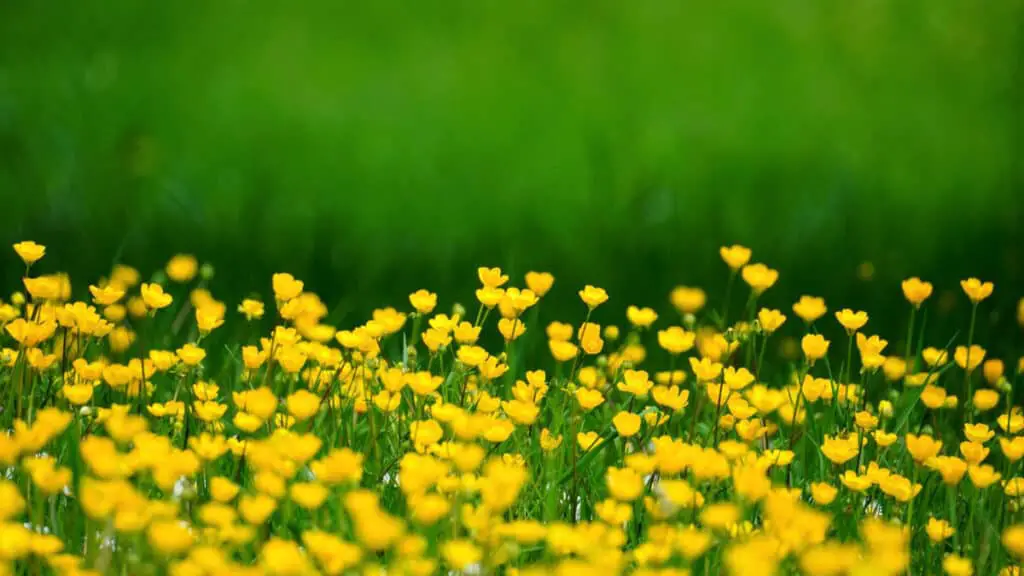Skip To Section
Can Horses Eat Buttercups?
No, they cannot. Buttercups, also known by the scientific name ranunculus, can be bothersome to horses in small amounts and toxic in large amounts. They can cause blistering and pain in both the flesh of the mouth and digestive tract if consumed.

Buttercups are a lovely yellow flower found all over North American that thrives in many soil varieties, especially during the rainy season. Horses usually avoid buttercups, but if their field has been overgrazed, they may consume the buttercups out of hunger.
Buttercups have a vast range but are less common the further north you get. They don’t do well in parched or freezing climates.
Read on to find out about the risks buttercups play to horses and how to avoid them being eaten by your favorite equine!
Are Buttercups Edible For Horses?
Buttercups are not edible for horses. When ingested in small amounts, or when bundled into dried hay, small amounts of ingested buttercups usually won’t bother a horse. It’s when a significant amount of the plant is eaten, especially when in bloom, that buttercup is at its most dangerous.
A horse would need to consume an extensive amount of buttercups to die from toxicity, but even the small blisters from eating a single plant can be incredibly uncomfortable for your horse. It’s best to not let them ingest any buttercups.
These yellow flowers have a bitter taste that horses tend to avoid, but some horses develop a taste for the flowers and will seek them out, making it even more important to avoid them growing in your grazing pasture.
Risks
The bright yellow buttercup flower and plant contain a toxic, irritating oil that is poisonous to horses.
Most buttercup ingestion just causes minor injuries, but medium to large amounts of buttercup can cause paralysis and death, making it incredibly important to avoid letting your house ingest any.
Horses won’t seek buttercups out in most cases, but a field with poor growth or one that has been overgrazed puts horses at risk for buttercup toxicity. When nothing else is available, horses will absolutely eat buttercups.
Encourage the growth of plants and grasses that horses and enjoy, and keep your horses well-fed, so they aren’t tempted to ingest bright yellow buttercups.
What Happens If A Horse Eats Buttercups?
Buttercup toxicity has quite a few symptoms.
Some of the more common ones include:
- Swelling
- Blisters of the muzzle and other parts of the mouth
- Ulcers
- Drooling
A few of the more severe side effects seen when horses eat buttercups are:
- Twitching
- Paralysis
- Convulsions
- Diarrhea, sometimes with blood
- Death
If you notice any of these symptoms, especially if your horse has recently been grazing in a field that has previously been infested with buttercups, call your vet right away. Even small amounts of buttercups can cause pain and distress in horses.
What Part Of A Buttercup Is Toxic to Horses?
The irritating oil found in buttercup plants is most concentrated in the flower, and throughout the rest of the plant, when in bloom. When not in bloom, the fresh plant is still toxic, but not as much so. Younger plants contain more irritating oil than older ones.
Dried buttercup plants are usually not bothersome to horses and commonly found bundled in hay bales with no negative consequences.
How Do You Get Buttercups Out Of A Horse Pasture?
The most important first-line defense against buttercups is to keep the soil in your grazing pastures well-drained. Buttercups can grow in most types of soil, but their preferred growing areas are moist, or even swampy.
When left unchecked, buttercup can out-compete other, more desirable plants. With no intervention, buttercup can spread up to 40 square feet in a year, making it exceptionally prolific and damaging to other local plant life.
It has also been proven to lessen the amount of potassium in the soil, rendering the soil less appealing to other plants.
A drier, well-drained pasture will not be as desirable for buttercups to grow in.
If your field is well-drained but still infested with these bright yellow flowers, tilling and spraying can help curb the outbreak. Having a good pasture management program, that includes mowing, fertilizing, and grazing is also of the utmost importance for controlling the growth of unwanted plants.
Buttercups also resemble quite a few non-toxic flowers, so doing a fair amount of research so you can easily identify buttercups can go a long way towards avoiding being overrun by them.
Conclusion
Consuming buttercups is toxic to horses, and the effects of consumption can range from mildly bothersome to deadly.
Horses will usually avoid buttercups but may consume them if nothing else is available.
Buttercups thrive on poor, overly moist soil and can be discouraged with a solid pasture management program.
Once you recognize what a buttercup plant looks like and have a game plan to combat them, you can rest assured that your horses are protected against this bright yellow troublemaker.
